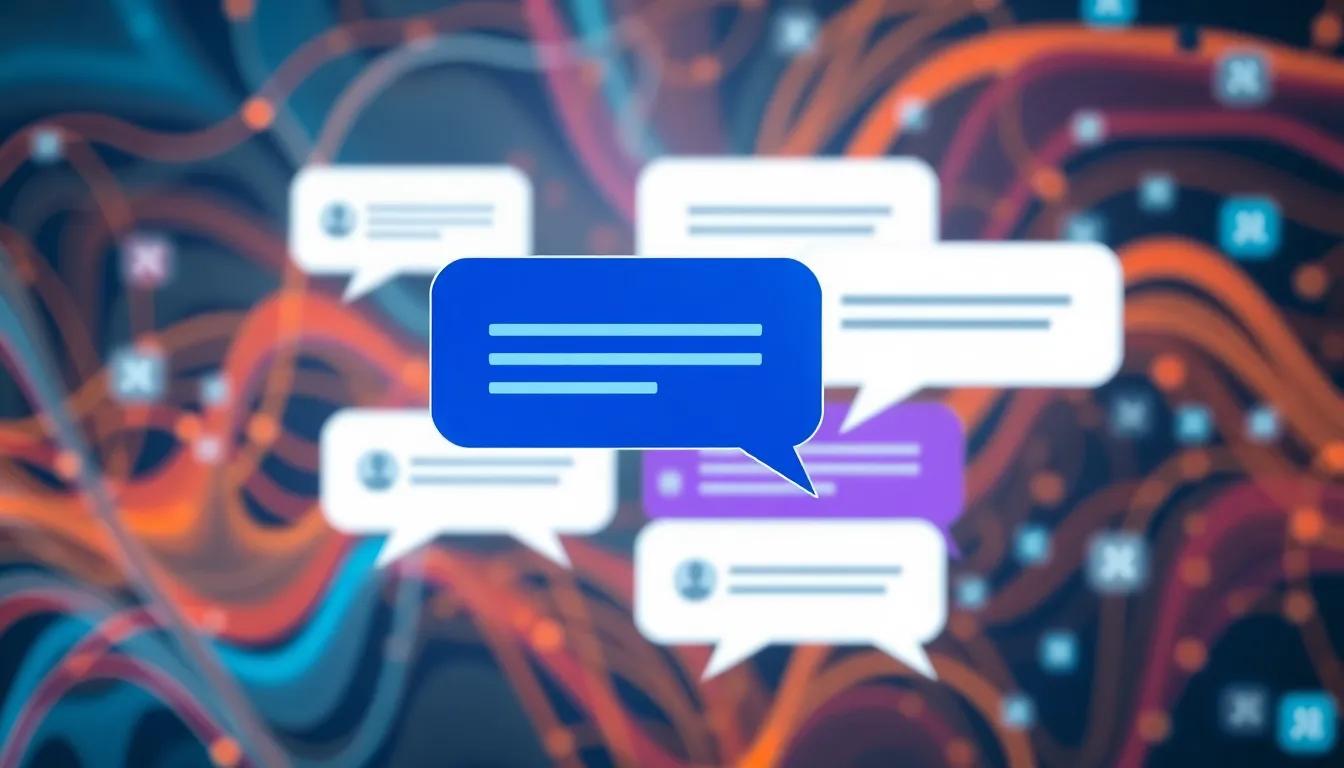Introduction
Engaging potential customers through effective communication is crucial for any website’s success. One of the most effective tools for enhancing user interaction is the chat widget. This compact, interactive feature allows for real-time communication between visitors and support agents, thus creating a more personalized experience. Implementing chat widgets can significantly improve customer satisfaction and drive conversions, making it essential for businesses looking to increase their online presence.
By integrating stylish, user-friendly chat interfaces and utilizing the latest technologies, businesses can foster deeper connections with their audience. We will delve into best practices, optimization techniques, and the strategic use of chat widgets to enhance overall website performance and user experience.
Understanding Chat Widgets Their Role in Customer Engagement
Chat widgets are interactive tools embedded within websites that facilitate real-time communication between businesses and their customers. Acting as a bridge, these widgets enable users to ask questions, seek support, and engage directly with brands, thereby enhancing customer engagement significantly. By providing instant assistance, chat widgets serve not only to resolve queries but also to build a rapport, ultimately contributing to higher customer satisfaction and loyalty.
There are several types of chat widgets, each designed to cater to different interaction needs. Live chat options consist of actual human agents who respond to user queries in real time. This model is especially effective for industries that require personalized service, such as finance or healthcare, where immediate human interaction is critical. Live chat allows businesses to address complex queries that may require more nuanced understanding, helping to foster trust and engagement.
On the other hand, AI chatbots are automated conversational agents. They can handle a range of tasks, from answering FAQs to guiding users through basic procedures, making them ideal for businesses with a high volume of inquiries. These chatbots can be programmed to provide 24/7 support, ensuring that potential customers receive assistance even outside regular business hours. They are particularly effective for e-commerce platforms where users frequently have questions about product availability, shipping details, or return policies.
Hybrid models combine both live chat and AI chatbot functionalities, offering a balanced approach. Initially, an AI chatbot can handle simpler inquiries, providing immediate responses for routine questions. If the user’s needs surpass the chatbot’s abilities, the conversation can be seamlessly transferred to a human agent. This model maximizes efficiency while still offering personalized support, making it a popular choice for businesses aiming to improve user satisfaction without sacrificing quality.
Understanding these different types of chat widgets and their functionalities is paramount for businesses looking to enhance their online presence and customer engagement. By tailoring chat solutions to specific needs, companies can create an interactive environment that not only captures customer interest but also effectively addresses their concerns, thereby maximizing the potential for conversion and satisfaction.
Choosing the Right Chat Widget for Your Business
Guidance on Selecting the Best Chat Widget for Different Business Needs
Choosing the right chat widget for your business is pivotal for enhancing customer engagement and satisfaction. The decision should be rooted in a thorough understanding of your target audience, website size, and specific customer service objectives. Each of these factors significantly influences which type of chat solution will best connect with your visitors.
When considering your target audience, take into account their preferences and behaviors. For instance, a younger demographic may appreciate an interactive AI chatbot that provides instant feedback and assistance, creating a more engaging experience. Conversely, industries serving a more mature audience may benefit from traditional live chat systems staffed by human agents, offering a personal touch that is essential in building trust.
The size of your website can also dictate the appropriate chat widget choice. Smaller businesses might find that a simple live chat option suffices for managing customer inquiries, while larger organizations may require more sophisticated, multi-faceted chat solutions that incorporate AI capabilities and analytics. This ensures that high volumes of interactions can be efficiently handled without sacrificing quality. Take into account the potential traffic to your site; if you anticipate thousands of visitors, a robust system that integrates seamlessly with your existing customer service tools is crucial.
Another key determinant is your customer service goals. Are you aiming to provide 24/7 support? If so, implementing an AI chatbot that can handle common questions and issues at any hour allows your team to focus on more complex concerns during business hours. If your goal is to enhance customer relationships through direct communication, opt for chat widgets that prioritize human interaction, enabling real-time conversations and fostering loyalty.
It’s also wise to assess the features of various chat widgets available in the market. Look for customizable options that allow you to adapt the chat interface to reflect your brand’s persona. Evaluate integration capabilities with CRM systems, ensuring you can maintain customer histories and streamline interactions for a smoother service experience.
Determining the right chat widget involves assessing your audience’s needs, understanding your website’s size, and aligning your choice with your customer service objectives. A well-chosen chat widget can significantly impact user engagement and customer satisfaction, driving conversions and fostering positive relationships.
Optimizing Your Chat Widget for User Experience
Enhancing User Interaction with Design and Functionality
To maximize website engagement and customer satisfaction, the design and functionality of your chat widget play a pivotal role. A well-optimized chat widget should be user-centric, ensuring that visitors can easily connect with your business without any friction. Here are key tips to enhance the user experience through effective layout, visibility, and interaction.
Consider the layout of your chat widget. It is advisable to position the widget in a prominent spot on the webpage, such as the bottom right corner. This placement is familiar to users and allows for easy access without obstructing the main content. Use a compact design that only expands when clicked, allowing users to opt-in for assistance when they choose, thereby reducing the initial clutter on the screen.
Visibility is equally crucial. Make sure your chat widget stands out against your website’s background. Utilizing contrasting colors and clear, intuitive icons will help grab users’ attention. Additionally, ensure that the chat widget is responsive and mobile-friendly. As more users browse the web on their mobile devices, it is essential that the chat widget adapts seamlessly to various screen sizes, providing a consistent user experience across platforms.
For interaction, set up proactive chat invitations that appear based on user behavior, such as time spent on a page or specific actions taken. This can prompt engagement at critical moments, leading to higher interaction rates. Personalize messages by addressing visitors with dynamic content, such as their name or referencing the page they are on, creating a more tailored experience.
It’s also beneficial to streamline the chat interface by focusing on clarity and ease of use. Limit the number of input fields and provide quick-response buttons for common queries. This approach not only accelerates response time but also makes the interaction more engaging for users who may not want to type lengthy messages.
Consistently test and optimize the chat widget based on user feedback and analytics. Monitoring user interactions can provide valuable insights into what works and what doesn’t, allowing for ongoing improvements to enhance usability. By implementing these strategies, you can significantly improve the overall user experience, leading to increased engagement and ultimately, higher customer satisfaction.
Leveraging AI and Automation in Chat Widgets
Enhancing Responsiveness and Engagement through AI
The integration of AI and automation in chat widgets is a game-changer for website engagement. These technologies allow businesses to provide immediate responses to customer inquiries, considerably reducing wait times. When users interact with a chat widget, they expect answers without delay. AI-driven chat solutions can handle multiple queries simultaneously, ensuring that no customer is left waiting. This incredible speed enhances the overall user experience, making customers feel valued and understood.
Utilizing AI algorithms enables chat widgets to learn from interactions. Machine learning components analyze user behavior, allowing the system to recognize common questions and frequently encountered issues. Over time, the widget becomes increasingly adept at providing accurate answers or directing users to relevant resources, such as FAQs or product pages. This learning capability ensures that every interaction becomes more precise, prompting repeat visits and enhancing customer satisfaction.
Improving Customer Satisfaction with Automation
Automation elevates chat widget performance by allowing seamless transitions between automated responses and live agent support. When the chatbot encounters a complex question that it cannot answer, it can promptly escalate the conversation to a human agent, preserving the continuity of customer interactions. This integration keeps the dialogue flowing and shows users that their concerns are taken seriously. It combines the efficiency of automation with the nuanced understanding of human agents, satisfying a wider range of customer needs while maintaining engagement.
The implementation of proactive messaging further enriches user interaction. AI can analyze on-site behavior, prompting unsolicited messages to guide users at crucial moments, such as when they spend an extended time on a product page. A simple, friendly suggestion offering assistance can lead to higher conversion rates, as users appreciate the tailored attention and are more likely to engage in a purchase or inquiry.
Incorporating natural language processing (NLP) technology to understand user intent and context also significantly enhances interaction quality. With NLP, chat widgets can generate contextually relevant responses, making conversations feel more organic and less robotic. This human-like interaction fosters trust, encouraging users to engage more openly and extensively, ultimately creating a rich and satisfying experience.
Integrating Chat Widgets with Other Communication Channels
Creating a Seamless Customer Experience
The integration of chat widgets with various communication channels such as email, social media, and SMS is vital for enhancing user engagement. In an age where customers expect instantaneous support, a unified approach to communication can significantly elevate their experience. When users can transition seamlessly between different platforms, they are less likely to feel frustrated or ignored, which ultimately leads to higher customer satisfaction.
To start, linking chat widgets with email systems enables businesses to maintain a consistent dialogue. A user might initiate a conversation on a chat widget and later continue it via email if they prefer a more detailed interaction. By enabling this continuity, companies can ensure that no pertinent information is lost, enhancing the overall customer journey. Automated summaries or follow-up emails containing chat transcripts can be particularly helpful in keeping customers informed.
The integration with social media is equally important. Many customers use platforms like Facebook, Instagram, or Twitter for engagement with brands. Integrating chat widgets into these channels allows users to communicate through their preferred medium. For instance, a chat initiated on a website can be redirected to a brand’s Messenger platform, keeping the user engaged without the need to start over. Companies can employ chatbots on these social media platforms to answer frequently asked questions, which can escalate to a live chat when more complex issues arise.
Text messaging via SMS has also emerged as a vital communication channel. By incorporating chat widgets that facilitate SMS communication, businesses can reach customers in a more direct and personal manner. This method is excellent for reminders, confirmations, and urgent communications, making it more likely for customers to respond quickly. Furthermore, having an omnichannel approach means that customers can conveniently choose how they wish to communicate according to their preferences.
Integrating chat widgets with other communication channels fosters a collaborative and cohesive environment. This fusion not only enhances user convenience and satisfaction but also provides businesses with valuable insights about customer preferences. As the landscape of customer interaction continues to evolve, maintaining this integration will be essential for businesses aiming to create a truly exceptional customer experience.
Monitoring and Analyzing Chat Widget Performance A Key to Engagement
Why Monitoring is Vital
Monitoring chat widget performance through analytic tools is essential for maximizing user interaction and enhancing overall customer satisfaction. By keeping a close watch on how the widget performs, businesses can gain invaluable insights into the behavior and preferences of their users. This data-driven approach not only helps in assessing engagement levels but also identifies potential pain points within the chat experience, allowing for timely adjustments that lead to improved metrics.
Measuring Success
To effectively measure the success of a chat widget, several key performance indicators (KPIs) should be monitored:
- **Engagement Rate**: Track how many users interact with the chat feature versus those who visit the website. This reveals the widget’s ability to draw in users.
- **Response Time**: Measure how quickly agents respond to inquiries. Faster response times often correlate with higher customer satisfaction.
- **Resolution Rate**: The percentage of queries resolved in the first interaction indicates the efficiency and effectiveness of the chat widget.
- **Customer Satisfaction Score (CSAT)**: Utilize post-chat surveys to gauge user satisfaction directly, providing qualitative data that complements quantitative metrics.
Identifying Areas for Improvement
Data collection is only the starting point. Analyzing this information is crucial to pinpoint areas that require enhancement. For instance, if the engagement rate is low, revisiting the placement and visibility of the chat widget might be necessary. Enhancements can include making the widget more prominent on high-traffic pages or reducing the number of clicks needed to initiate a chat.
Analyzing customer feedback gathered through CSAT can highlight common issues customers face. If a notable percentage of users report unsatisfactory experiences, it may indicate inadequacies in the chat script, need for better training for support agents, or even technical disruptions that must be addressed.
Ongoing evaluation transforms the chat widget from a static feature into a dynamic tool for user interaction. By constantly fine-tuning the widget based on real-time analytics and user feedback, businesses can cultivate a more engaging and responsive customer service experience, thus enhancing overall satisfaction and retention rates.
Future Trends in Chat Widgets and Customer Engagement
Evolution of Chat Widgets: Voice Recognition and Advanced AI
In the quest to enhance user interaction and customer satisfaction, the landscape of chat widgets is experiencing a significant transformation. One of the most promising trends is voice recognition technology, which allows users to engage in conversation using natural speech. This development caters to the growing preference for voice-based interactions, presenting a more convenient alternative to traditional text-based communication. As technology progresses, chat widgets will likely incorporate features that enable seamless voice conversations, recognizing accents and context to improve understanding.
Alongside voice recognition, the advancement of artificial intelligence capabilities plays a crucial role in shaping the future of chat widgets. AI is becoming increasingly sophisticated, providing chatbots with the ability to understand nuances in queries and deliver personalized responses. For instance, modern AI-driven chat widgets can analyze user behavior and preferences, leading to tailored interactions that resonate with individual customers. With machine learning algorithms continually improving, these chat widgets will enhance their accuracy, making conversations feel more human-like and relevant.
Omnichannel Coordination and Predicting Customer Engagement Trends
The significance of omnichannel coordination is also apparent in the evolution of chat widgets. As customers engage with brands across multiple platforms—from social media to websites—integrating chat functions across these channels ensures a consistent user experience. Future chat widgets will likely provide seamless transitions, allowing conversations to continue across devices, thus maintaining engagement without interruptions. This coordination fosters a unified brand presence and enables businesses to cater to customer needs at every stage of their journey.
It is essential to anticipate further developments in customer engagement through chat widgets. Trends may include the integration of augmented reality (AR) for enhanced user experiences, where virtual shopping assistants provide real-time assistance and product visualization. Furthermore, increased data privacy measures will necessitate chat widgets to work within secure frameworks while still delivering personalized content. Companies that adapt to these shifts and invest in these emerging technologies are more likely to foster strong customer relationships and stay ahead of industry competition.
Conclusions
Implementing chat widgets is a highly effective strategy for boosting website engagement and improving customer satisfaction. By carefully choosing the right tool and optimizing its functionality, businesses can create meaningful interactions with their audience. Understanding the importance of user-friendly design, leveraging AI capabilities, and integrating with other channels contributes significantly to successful outcomes.
The future of website engagement lies in continued innovation within chat widget technology. As customer expectations evolve, businesses must stay ahead of the curve, utilizing advanced tools to foster connections that lead to growth and loyalty. By staying informed and flexible in their approach, companies can ensure that they make the most of this essential communication tool.



















